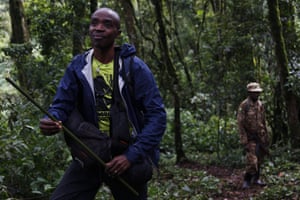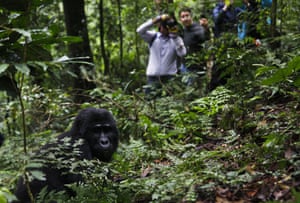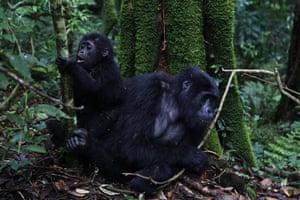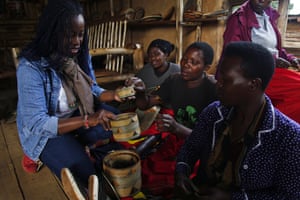As he clambers down the forested ravine, soil slipping beneath his boots, Dr Fred Nizeyimana knows they are close. “I can smell them,” he says, just before the mountain gorillas come into view high in the canopy, plucking leaves and chomping on the vegetation. An adult female slides down a tree, a flash of black fur and elongated limb. More follow, with infants and juveniles in tow. A grunting silverback descends to join its family, the branches buckling beneath approximately 180kg (400lb) of iconic primate.

Then Nizeyimana, a specialist vet offering hands-on care in the wild, spots a remarkable scene. Ambling up the steep, wooded slope, another gorilla family has emerged from the valley floor. The first group look on, then head deeper into the primeval jungle of Uganda’s Bwindi Impenetrable national park – one of Africa’s most ancient habitats and home to almost half of the world’s mountain gorillas.
Such a close and well-populated encounter with one of humankind’s nearest relatives (witnessed before the Covid-19 pandemic) would have been inconceivable during the dark days of the early 1980s, when it was estimated that there were only 250 mountain gorillas in the Democratic Republic of the Congo’s (DRC) Virunga national park, and around 100 thought to be in Bwindi. That all-time low prompted fears they would vanish by the end of the 20th century. Even in early 2018, the conservation status of these gorillas put them one step away from extinction.
Now, thanks to a far-reaching initiative, a recent census has revealed the number of known mountain gorillas has increased to 1,063 – taking them off the red list of critically endangered species. Amid climate chaos and unbridled habitat destruction, this is a momentous achievement, albeit one that could now be reversed by the coronavirus pandemic.
Experts who led the revival put their success down to engaging local communities, securing government support and promoting transnational collaboration, a three-pronged strategy that could offer beleaguered areas worldwide a roadmap to recovery.
“When done well, this can be a phenomenal success,” says Dr Timothy Tear, executive director of the Wildlife Conservation Society’s Africa programme, which has been involved in the decades-long campaign to save the mountain gorilla. “We need to be recognising there are many more opportunities to do things like this in other countries.”
Environmentalists stress the importance of giving local communities a stake in the survival of the local area, ensuring they profit from ecotourism and other money-making activities that provide alternatives to hunting and resource exploitation. These income streams can fuel a country’s economic vitality, winning state support by helping to assert the animals’ worth to policymakers in capitals far from wilderness areas.
“The revenue that mountain gorillas produce is a major reason why governments are valuing this resource,” says Tear.
Permits to visit gorillas for one hour start at $600 (GBP479) per person in Uganda, rising to $1,500 in Rwanda. These sums are eye-watering, but crucial. Worldwide, up to $400bn a year is needed to conserve healthy ecosystems, a Credit Suisse report estimates, a long way from the $52bn actually raised.

Mountain gorilla habitats span Rwanda, Uganda and the war-wracked DRC, so partnerships unconstrained by political frontiers are essential. Such “conservation diplomacy” played out in 2015 when the three countries signed a treaty committing to coordinate the conservation of the region.
“Not any one country could have, on its own, been responsible for the recovery,” says Anna Behm Masozera, director of the IGCP, a regional coalition of environmental groups.
But serious threats remain, from irresponsible development to climate change – and now Covid-19.
Our simian ancestors share about 98% of human DNA and can catch respiratory diseases from people, with deadly consequences. Leading scientists warned last month that Covid-19 poses an “existential threat” to primates and that, for mountain gorillas in particular, the introduction of a new, highly-infectious disease could be a “potential extinction-level event”. In response, rangers in Bwindi are now required to wear face masks, use hand sanitiser and keep their distance from the apes.
The suspension of ecotourism during the coronavirus pandemic has also meant the main source of revenue for gorilla conservation has been lost and there are fears some of those in surrounding communities who depend on tourists could turn to poaching out of desperation. “We are worried,” says Bashir Hangi, a spokesman for the Uganda Wildlife Authority, the state body that manages Bwindi and nine other national parks. “If this continues, it’s definitely going to reverse the achievements. There’s no doubt about it.”
Back from the brink
Ever since a young military officer named Oscar von Beringe discovered mountain gorillas (then promptly shot two of them) in 1902, these magnificent mammals have endured persecution. Disease, hunting and habitat destruction have blighted their two populations, split between Bwindi in Uganda and the Virunga range of extinct volcanoes that straddle DRC, Rwanda and Uganda.
It was in 1979 that conservation groups first started collaborating to protect the dwindling population, founding the Mountain Gorilla Project to run tourism and education initiatives to change local attitudes. But gorilla numbers continued to drop, whether they were dying in traps intended for antelope, or being killed in retaliation for raiding crops. Grisly trinkets made from their hands and heads were sold in tourist markets.

The legendary primatologist Dian Fossey began using uncompromising methods to pull these critically-endangered creatures back from the brink, from repelling herders by spray-painting cattle to directly confronting poachers, many of whom were impoverished locals with few options.
In 1985, a few weeks before her 54th birthday, Fossey was murdered in Rwanda. Her killers were never found. Shortly before her murder, Fossey had said she feared there would be no mountain gorillas left within 15 years.
But a census one year after her death revealed the opposite; numbers were increasing. “There was a glimmer of success,” says Behm Masozera, the IGCP’s director. “In order to sustain that success, a more cohesive programme was built around it.”
This resulted in the International Gorilla Conservation Programme (IGCP) – a coalition of nonprofits comprising Conservation International, Fauna & Flora International and WWF that was more formalised than the Mountain Gorilla Project, with a remit across DRC, Rwanda and Uganda. This long-term alliance, argues one member, should be replicated elsewhere. “This is entirely the way we need to be working,” says Cath Lawson, regional conservation manager for Africa at WWF-UK, “to have that transformational change for wildlife like mountain gorillas to thrive.”
In 2003, despite DRC’s protracted conflict and the earlier horrors of the Rwandan genocide, sustained efforts had increased Virunga’s population to 380. An additional 320 in the cloud forests of Bwindi brought the total population to 700 individuals. The upward trajectory continued, propelled by 2015’s intergovernmental treaty. Snares, fashioned from ropes or wires that cut deep into gorilla flesh, began to disappear.
By November 2018 the number of known mountain gorillas reached 1,063. But there is no room for complacency. “Yes, this demonstrates what we can achieve,” says Lawson. “But it’s not a done deal.”
Ecotourism has played a central role in this conservation triumph, alongside a scheme that splits the revenue with nearby communities, adapting earlier divisive models of “fortress conservation” into something more inclusive and equitable.
Undeniably, though, coercive methods to protect wildlife have devastated traditional life for Batwa “pygmies”, a forest-dependent indigenous minority who were evicted in their thousands from Bwindi and other Ugandan parks as protection activities ramped up in the early 1990s and continue to suffer today.
Yet other local communities hail the Bwindi project – and its pragmatic fusion of wealth creation with environmentalism – as a genuine gain.

The Change A Life Bwindi charity trains former poachers in beekeeping, mothers in basket weaving, and teenage girls unable to afford school in tailoring. These income-generating activities emphasise the advantages of living near a thriving gorilla population to which cash-rich westerners are drawn daily.
“We see Bwindi as a good thing,” says Hilda Ariho, a 30-year-old community leader. “It brings tourists here and without it we’d be poorer. It’s helping a lot of women.”
Back inside the park, after Nizeyimana spots the two gorilla families, a group of tourists have one hour to absorb the scene, whether by taking a slew of selfies or observing in quiet contemplation.
The tourists depart and the silverback reclines, watching over his relatives in a mountainous landscape that for approximately 25,000 years has woven itself into an awe-inspiring tangle of vines, trunks and creepers across the Albertine Rift valley.
Conservationists are hoping that these mountain gorillas continue to thrive and that the latest threat, Covid-19, can be beaten.
Find more age of extinction coverage here, and follow biodiversity reporters Phoebe Weston and Patrick Greenfield on Twitter for all the latest news and features